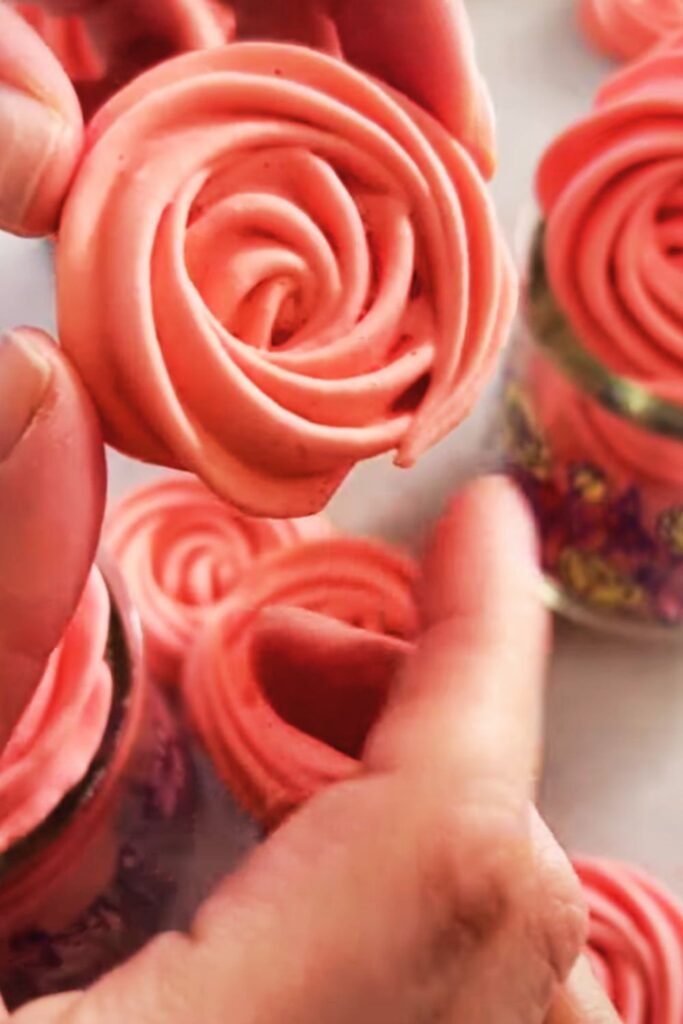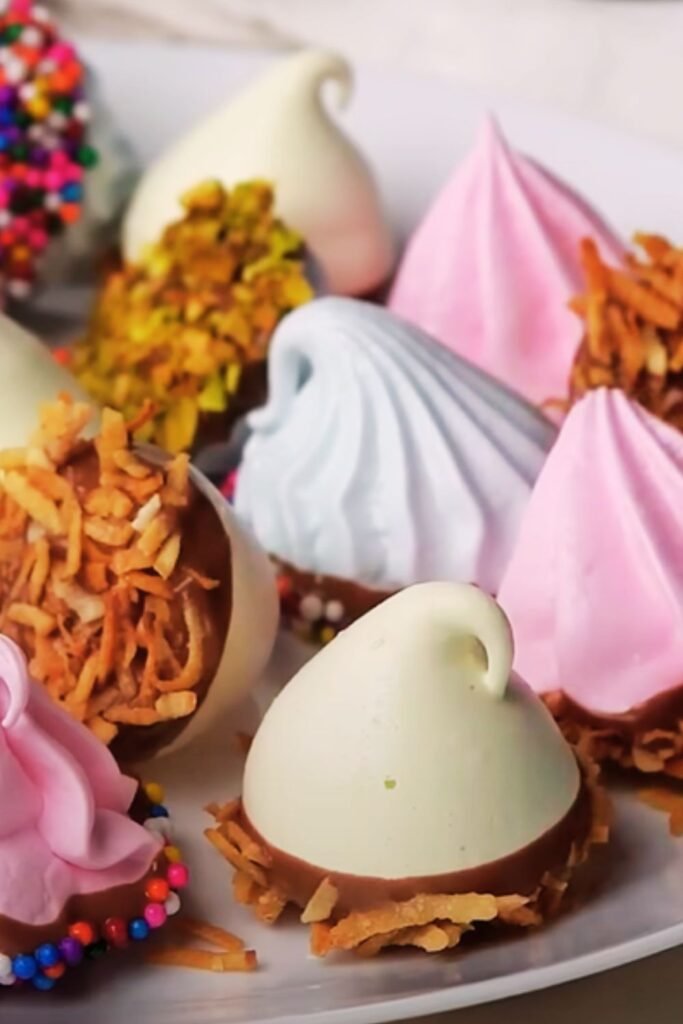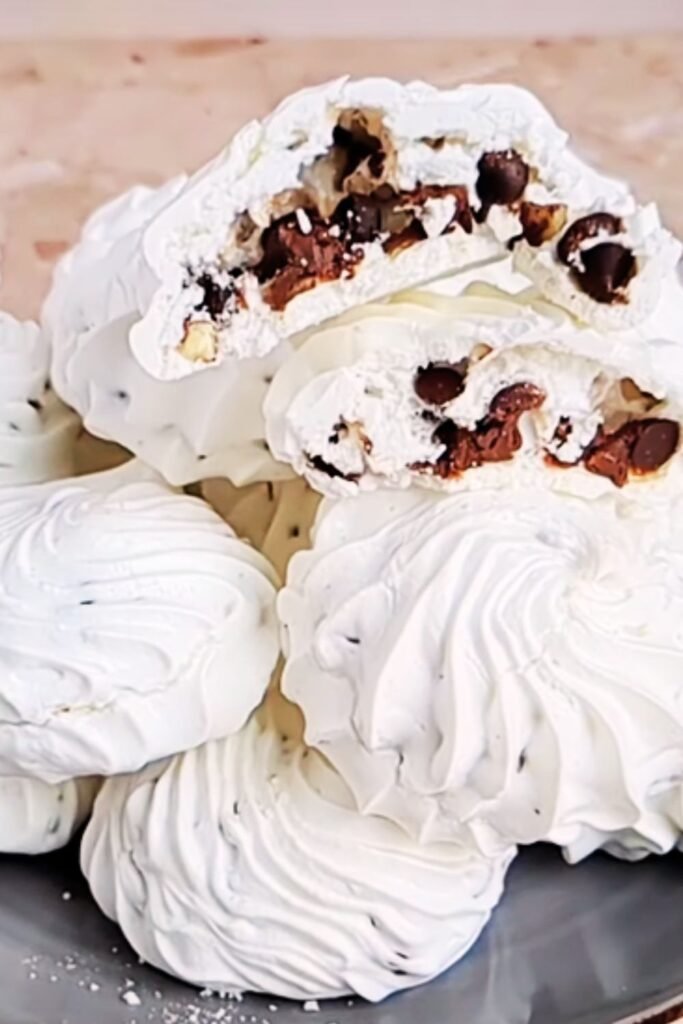When I first encountered meringue rose cookies at a charming Parisian patisserie, I knew I had to master this ethereal confection. These delicate, flower-shaped treats combine the crisp lightness of meringue with the romantic elegance of roses, creating something truly magical for both the eyes and palate.
The art of crafting meringue rose cookies represents a beautiful intersection of technique and creativity. Unlike traditional cookies that rely on flour and butter, these airy confections depend entirely on properly whipped egg whites and sugar, transformed through careful piping into stunning rose shapes that seem almost too beautiful to eat.
Understanding Meringue: The Foundation of Excellence
Meringue : A foam made from whipped egg whites and sugar, creating a light, airy texture that can be shaped and baked into crisp confections.
Swiss Meringue : Egg whites and sugar heated together before whipping, resulting in a more stable and less grainy texture than French meringue.
French Meringue : The simplest meringue method where sugar is gradually added to whipped egg whites at room temperature.
Italian Meringue : Hot sugar syrup is poured into whipped egg whites, creating the most stable meringue that’s ideal for decorative work.
The magic of meringue lies in its simplicity and the science behind it. When egg whites are whipped, proteins unfold and trap air bubbles, while sugar stabilizes this foam structure. The key to perfect meringue rose cookies lies in achieving the right consistency – firm enough to hold intricate piped shapes yet tender enough to dissolve beautifully on the tongue.

Essential Ingredients and Their Roles
Creating exceptional meringue rose cookies requires understanding how each ingredient contributes to the final result:
| Ingredient | Function | Quality Indicators | Measurement Tips |
|---|---|---|---|
| Egg Whites | Structure foundation | Room temperature, no yolk traces | Age 3-5 days for better whipping |
| Superfine Sugar | Stabilization and sweetness | Fine crystals, pure white | Dissolves completely when rubbed |
| Cream of Tartar | Acid stabilizer | Fresh, white powder | Prevents overbeating collapse |
| Food Coloring | Visual appeal | Gel-based preferred | Use sparingly for pastel tones |
| Rose Extract | Flavor enhancement | Pure, not artificial | Start with minimal amounts |
| Cornstarch | Texture modifier | Smooth, no lumps | Optional for chewier center |
The quality of your egg whites makes an enormous difference in the final product. I always use eggs that have been separated at least three days prior, as slightly aged whites whip more easily and create more stable foam. Room temperature eggs incorporate air more readily than cold ones, so I remove them from the refrigerator about an hour before baking.
Step-by-Step Preparation Method
Equipment Preparation
Before beginning, I ensure all equipment is scrupulously clean. Even the slightest trace of fat can prevent egg whites from whipping properly. I wipe down my mixing bowl and whisk with white vinegar, then dry thoroughly.
The Meringue Process
Initial Whipping Stage I begin whipping egg whites at medium speed until they become foamy and opaque. This typically takes 2-3 minutes with a stand mixer. At this point, I add cream of tartar, which acts as an insurance policy against overbeating catastrophes.
Sugar Incorporation The sugar addition requires patience and precision. I add it gradually, about one tablespoon at a time, allowing each addition to dissolve completely before adding more. This process takes approximately 8-10 minutes, but rushing leads to grainy, unstable meringue.
Achieving Perfect Peaks I whip until the meringue reaches stiff, glossy peaks that hold their shape when the whisk is lifted. The mixture should feel smooth when rubbed between fingers, with no grittiness from undissolved sugar.
Coloring and Flavoring
For rose-colored meringue, I use gel food coloring rather than liquid, which can destabilize the foam. I start with just a tiny amount – the color will intensify as it mixes. Rose extract requires an equally light touch; too much creates an overpowering, soapy flavor that overshadows the delicate sweetness.

Piping Techniques for Perfect Roses
The artistry of meringue rose cookies lies in the piping technique. I use a large star tip (Wilton 1M or 2D work beautifully) fitted into a piping bag. The bag should be twisted tightly at the top to prevent air bubbles and ensure consistent pressure.
Rose Piping Method:
- Start from the center with a small spiral motion
- Work outward in overlapping layers
- Apply steady, even pressure throughout
- Finish with a quick upward motion to create the outer petals
- Each rose should be approximately 2 inches in diameter
The key to natural-looking roses lies in varying the pressure slightly as you pipe, creating organic-looking petals rather than perfectly uniform spirals. I practice this motion several times without the bag filled to develop muscle memory.
Baking Parameters and Techniques
| Temperature Setting | Time Duration | Oven Position | Expected Results |
|---|---|---|---|
| 200°F (93°C) | 2-3 hours | Center rack | Crisp throughout |
| 225°F (107°C) | 1.5-2 hours | Lower third | Slightly chewy center |
| 175°F (79°C) | 3-4 hours | Center rack | Maximum crispness |
| Convection 200°F | 1.5-2 hours | Any position | Even browning |
Low temperature baking is absolutely crucial for meringue rose cookies. High heat causes the exterior to brown before the interior dehydrates properly, resulting in chewy or sticky centers. I prefer 200°F as it provides the perfect balance between reasonable baking time and proper texture development.
During baking, I resist the temptation to open the oven door frequently, as temperature fluctuations can cause cracking or collapse. The cookies are done when they lift easily from the parchment paper and sound hollow when tapped gently.

Troubleshooting Common Challenges
Weeping Meringue When meringue releases moisture during or after baking, it usually indicates insufficient sugar incorporation or high humidity. I combat this by ensuring complete sugar dissolution and avoiding baking on humid days when possible.
Cracked Surfaces Surface cracks typically result from temperature shock or overmixing. I solve this by maintaining consistent oven temperature and stopping the mixer as soon as stiff peaks form.
Flat or Collapsed Shapes Shape collapse often stems from underbeaten whites or contamination with fat. I prevent this through meticulous equipment cleaning and proper peak development before piping.
Sticky Texture Stickiness indicates incomplete dehydration or sugar crystallization issues. I address this by extending baking time and ensuring proper sugar dissolution during mixing.
Storage and Serving Recommendations
Proper storage maintains the delicate texture that makes these cookies special. I store completely cooled meringue roses in airtight containers with parchment paper between layers. Silica gel packets help absorb any residual moisture, keeping cookies crisp for up to one week.
Optimal Serving Suggestions:
- Afternoon tea accompanied by delicate leaf teas
- Elegant dessert presentations with fresh berries
- Wedding favors in decorative boxes
- Holiday cookie platters with complementary flavors
- Gift arrangements for special occasions
These cookies pair beautifully with lighter beverages that won’t overwhelm their subtle flavor. Champagne, sparkling water with fruit, or herbal teas create lovely accompaniments for special celebrations.
Nutritional Information and Dietary Considerations
| Nutrient | Per Cookie (1 medium rose) | Daily Value % |
|---|---|---|
| Calories | 25-30 | 1-2% |
| Carbohydrates | 6-7g | 2-3% |
| Sugar | 6-7g | – |
| Protein | 1g | 2% |
| Fat | 0g | 0% |
| Sodium | 10-15mg | <1% |
| Cholesterol | 0mg | 0% |
Meringue rose cookies naturally accommodate several dietary restrictions. They’re completely fat-free and contain no dairy, making them suitable for those avoiding cholesterol or following low-fat diets. However, they’re not appropriate for those avoiding sugar or following ketogenic diets due to their high sugar content.
Flavor Variations and Creative Adaptations
While classic rose remains my favorite, numerous flavor variations can transform these delicate cookies:
Lavender Honey Meringue Roses I substitute honey for a portion of the sugar and add dried lavender buds for an aromatic twist that evokes French countryside charm.
Lemon Zest Garden Roses Fresh lemon zest and a touch of lemon extract create bright, citrusy versions perfect for spring celebrations.
Vanilla Bean Elegance Real vanilla bean paste creates sophisticated flavor depth while maintaining the classic white appearance.
Chocolate Drizzled Varieties After cooling completely, I drizzle melted chocolate in artistic patterns for added richness and visual appeal.
Professional Tips for Consistent Success
Through years of perfecting this recipe, I’ve discovered several professional secrets that ensure consistent results:
Humidity Management I avoid making meringue on days with humidity above 60%, as atmospheric moisture can prevent proper setting and create sticky textures.
Temperature Monitoring An oven thermometer helps maintain precise temperatures, as many home ovens fluctuate more than their displays indicate.
Timing Coordination I prepare all ingredients and equipment before separating eggs, as egg whites begin deteriorating immediately upon separation.
Quality Control I taste-test meringue before piping to ensure proper sweetness balance and flavor intensity.
Frequently Asked Questions
Q: Why did my meringue turn out grainy instead of smooth? This happens when sugar doesn’t dissolve completely during whipping. I solve this by using superfine sugar and adding it very gradually, ensuring each addition dissolves before adding more. Sometimes I warm the sugar slightly in a low oven before use.
Q: Can I make these cookies ahead for special events? Absolutely! I often make them 2-3 days in advance. Store them in airtight containers with parchment between layers, and they maintain their crisp texture beautifully. Avoid refrigeration, which introduces moisture.
Q: What’s the best way to fix overbeaten meringue? Unfortunately, severely overbeaten meringue can’t be salvaged – it becomes grainy and separates. However, if caught early, I sometimes fold in an additional egg white very gently to restore some smoothness.
Q: Why do my roses lose their shape during baking? Shape loss usually indicates insufficient stiff peaks or contaminated egg whites. I ensure my mixing bowl is completely clean and whip until the meringue holds very firm peaks that don’t droop when the whisk is lifted.
Q: Can I add natural rose petals to the cookies? I sometimes garnish with dried, food-grade rose petals after baking, but never during the meringue-making process as they can introduce moisture and destabilize the foam structure.
Q: How do I prevent my cookies from sticking to the baking sheet? I always use parchment paper rather than greasing pans, as fat can cause spreading and texture changes. Silicone baking mats work well too, though parchment gives slightly better release.
Q: What’s the secret to getting vibrant colors without affecting taste? Gel food coloring provides intense color with minimal liquid addition. I start with tiny amounts – about 1/8 teaspoon – and add more gradually. Paste colors work similarly well and won’t thin the meringue.
Q: Can I pipe the roses directly onto serving plates? While possible, I don’t recommend this approach as the cookies need to cool completely on their baking surface. Attempting to move them while warm often results in cracking or breakage.
Creating perfect meringue rose cookies requires patience, practice, and attention to detail, but the results are absolutely worth the effort. These ethereal treats bring elegance to any occasion while showcasing the beautiful simplicity of properly executed technique. Whether you’re preparing them for a special celebration or simply want to master a classic confection, these delicate roses will undoubtedly become a treasured addition to your baking repertoire.
The journey from basic egg whites to stunning edible flowers never fails to amaze me, and I hope you’ll find the same joy in creating these beautiful, delicious treats that have brought such pleasure to my own baking adventures.